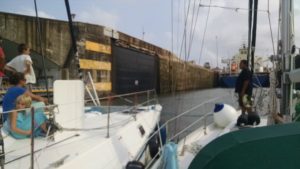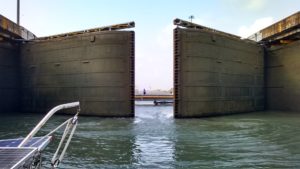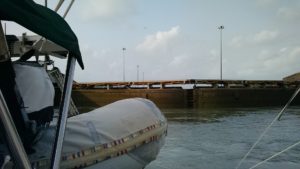
There probably isn’t any man-made structure that is more intimately related to its country as the Panama Canal is with Panama. When I went through it on my sailing trip, it was truly awesome.
The actual canal experience
Ironically, the Canal doesn’t look all that impressive when you see it at first, especially if there aren’t any boats in it. There are two “lanes” each of which is about 100 feet wide. So when you compare it to all the rivers you’ve seen in your life, it’s actually quite a bit smaller. But once you see one of the Panamax (ships specifically designed to be as large as the Canal will accommodate), you then start to realize what an amazing feat of engineering it is.
Panama is about 30 miles wide and obviously the canal cuts through that. On the Atlantic side there are three locks (more on these in a second) next to the port city of Colon. Then on the Pacific side there are three more locks next to the country’s capital of Panama City. In between the engineers dammed the Chagres River to make Lake Gatun which sits in the middle and is the path that ships go between the two sets of locks.

The locks are pretty amazing. Basically the boats go in these chambers that are 100 feet wide and about 1000 feet long (that’s what the Panamax boats need to fit into). Coming from the Atlantic Ocean we entered the locks at sea level where they were at their lowest points. After you enter the locks, the huge doors close behind you and you can see the walls rising about 35 feet above you.

Once the all clear sounds, they flood the chamber and the water level gradually rises, about a foot per minute, until the water level along with all the boats are 25 feet higher than when they entered. The doors at the other end open and you go into a second identical chamber, repeat the process, go into the third chamber and repeat the process. By the time you’re done with the third chamber, you are about 75 higher than when you started, 75 feet above sea level.

When we did it, of course we were on a much smaller sail boat, so we and two other sailboats “rafted” together, tied up to each other’s sides so we acted like one really wide sail boat, and entered the chambers behind a huge 800-foot long cargo ship.
We started the whole process at about 4pm. Once we got out of the third chamber and into Lake Gatun it was about 8pm so we slept there for the night. In the morning we motored across Lake Gatun, passing massive cargo ships going the other way. The lake is about 30 miles so the motoring took us about six hours. At about 2pm we came to the Pacific locks and repeated the whole process in reverse, and finally entered the Pacific Ocean at about 4pm. In 24 hours we went 40ish miles from the Atlantic to the Pacific. Without the canal, we would have gone all the way around the southern tip of South America which would be about 12,000 miles. Truly incredible.
There’s so much to say and 600 words won’t do it justice, so of course if you have any specific questions for me just let me know.
The Canal’s impact on Panama
I started this by saying how important the Canal is to the country, and it’s hard to overstate it. Panama wouldn’t exist as a country without the Canal. Back in the early 1900s, President Teddy Roosevelt knew that a canal would greatly benefit the United States economically, militarily, and politically. At the time, the land we call Panama was a part of the country of Columbia. Negotiations to build a canal with Columbia weren’t progressing so Roosevelt basically declared Panama and independent country. He signed a treaty with the new country to build a canal and the rest is history.
As an economic engine, the canal charges fees for ships to go through. For our small sailboat is was about $500, but for the big ones it can be in the hundreds of thousands of dollars. Those fees account for about 10% of the country’s economy. 10%!!!
Plus there is a ton of ancillary economic activity that occurs because of the Canal. The total all in for us to get through the Canal was about $2000. The $500 was directly to the Canal but then the other $1500 is for consultants who help you with all the paperwork and linehandlers who help guide you through the canal. Those are a lot of good jobs for a lot of Panamanians.
For big business, Panama City probably the biggest banking hub in Central America, thanks to all the business going through the Canal. Plus you have warehouses, fuel for the ships, hotels and groceries and all the other stuff you need with those ships coming through. It’s a huge economic driver.
In fact, that 10% actually is way underestimating how much the canal means to the country. When I flew in to Panama City, you pass the city skyline and I must say I was really impressed. It’s got to be the richest city in Central America and a rival to many Latin American cities like Mexico City or Sao Paulo, despite Panama City only having about 2 million people (the entire country has about 4 million people).
Generally speaking, in no specific order the richest countries in Central America are El Salvador, Panama, and Costa Rica. The reason Panama is on the list—THE CANAL. The average Panamanian makes about $13,000 per year. Costa Rica’s average is $11,000, Mexico and Brazil are $9,000, and countries like Guatemala and Honduras are less than $4,000. The Canal is probably single-handedly responsible for about 50% of the average Panamanian’s income, one way or another. Of course, I bring all this up because I am an economist but it truly is fascinating.
Put that all together, and the Canal is a singular structure in the world. I’m thankful I got to see it close up.
Really interesting. Never thought it took so long to get through those locks!